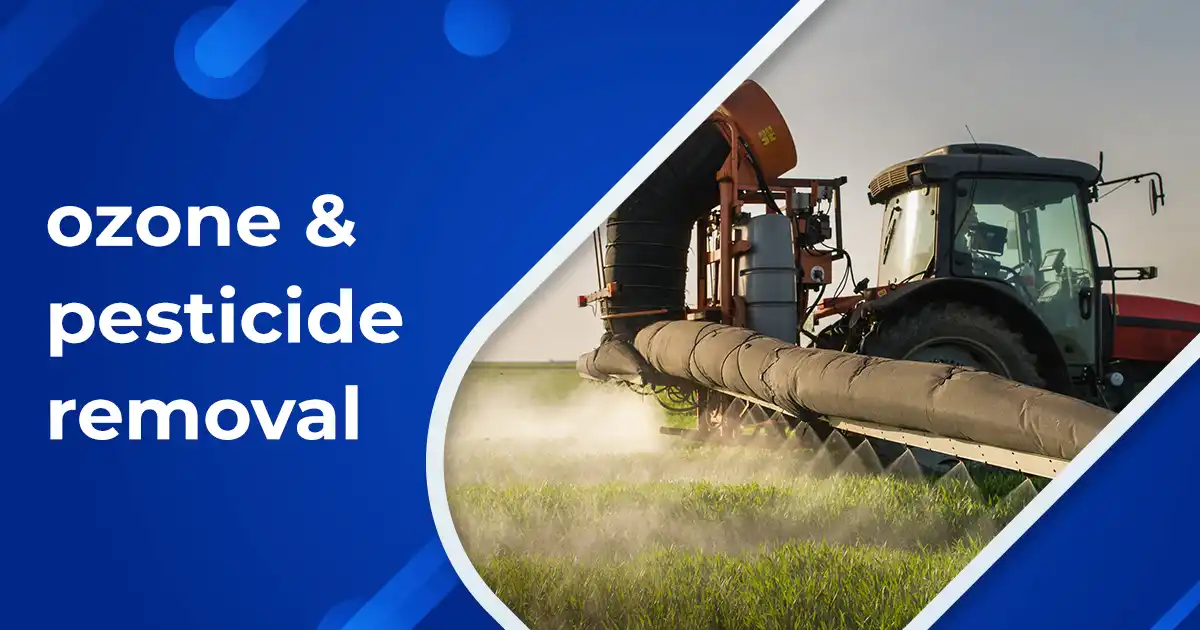ozone & pesticide removal
Posted on: March 18, 2022

Removal of toxins from water and waste water is a subject that is growing in importance in India. The fact that discharge norms have become strict has brought focus to the removal of toxic products from waste water. Municipal/potable/packaged water industries are also giving due importance to the acceptable levels allowable.
Pesticides are classified based on their target group like herbicides , insecticides , fungicides, rodenticides, nematicides etc . They are also classified based on their chemical structure like Organophosphates ,chloro-phenoxy carboxylic acids ,organo- chlorines , substituted urea , triazines to name a few.
Pesticides gain access to water and waste water due to the manufacturing process in waste water or contamination of ground water through waste water discharge by concerned industries
The technologies for removal of pesticide contamination will differ, for potable and drinking water and for wastewater. The higher contents of these toxic products in some wastewater make it more difficult to remove. A combination of both physical and chemical methods followed by a biological step in one way for the removal of pesticides from water . Physical methods include Nano Filtration, RO , Sand filtration and carbon filtration. Chemical methods include oxidation by ozone and AOP process and have been very successful in pesticide removal
But it must be noted that nether physical methods or chemical oxidation can guarantee complete removal of these toxic products from waste water . Chemical oxidation often result in incomplete destruction of pesticides and the by-products formed are still toxic in nature . Thus a combination of both physical as well as chemical oxidation is the right way to go for removal of pesticides and its by products from waste water
Ozonation is probably the better way for pesticide removal. AOP process using OH free radicals have also been evaluated useful for pesticides removal. (Including ozonation under high pH of over 8.0 ) The EOP of ozone is a high 2.07, only lower than OH free radicals and hence found to be very effective in degradation of recalcitrant organic pollutants in water and waste water .In waste water management the target of ozonation and AOP process is to detoxify the toxic products or at least convert them to easily bio degradable by products
The complexity of the reactions of these toxic products and by products with ozone and OH free radicals make it very difficult determine the degree of degradation. Mineralisation is very difficult and also the degraded by products could also be toxic. Due to this, Liquid Chromatography in many cases have not provided the correct results. Other measurements of TOC, DOC, COD could all provide some monitoring considerations. Toxicity assays are essential for an accurate determination
Use of Biologically active Carbon has found to be very use in pesticide removal. BAC has very large surfaces, well developed oxygen containing groups in well-developed internal pore structure
The most common treatment steps consists of
STEP 1: Primary treatment
STEP 2: Ozonation / AOP
STEP 3: secondary treatment preferably Biological
STEP 4: Tertiary treatment with Ozonation / AOP
STEP 5: BAC filtration
STEP 6: Coagulation
STEP 7: Sand filtration
EDC- micro pollutants a concern now.
EDC´s are substances which impact hormone function in animals and humans. Different groups of persistent micro pollutants are daily released by human activities into the water cycle .EDC´s (Endocrine Disrupting Compounds), pharmaceuticals (antibiotics, hormones) and , x ray contrast media, personal care products are groups of emerging contaminants all over the world . The role of ozone has been proven to be very effective in the removal of these micro pollutants

Shreyas Baratharaj | Director
Sheryas Barathraj has over 15 years of experience in municipal and industrial ozone applications. He has worked on some of the world’s largest ozone installations, with key interests in advanced oxidation, chemical synthesis, pharmaceutical water systems, and municipal drinking water treatment. LinkedIn Bio ›


